Historically, Yunnan has been the meeting place of the Southern Silk Road and the Ancient Tea Horse Road, where various cultures and minority groups have exchanged and blended. In addition, historical wars, immigration, and migration have contributed to the settlement of different minority groups in Yunnan. Various ethnic groups have preserved rich traditional culture and customs here. These cultures have been passed on and developed among the various minority groups, creating distinctive minority groups.
Yunnan is one of the most ethnically diverse provinces in China, with 25 ethnic minorities in addition to the Han Chinese. And 15 minority nationalities are unique in Yunnan. According to the data of the 2021 National Economic and Social Development Statistics Bulletin of Yunnan Province, at the end of 2021, the resident population of Yunnan Province was 46.9 million people, with 440,000 births in the year, a birth rate of 9.35 per thousand; 380,000 deaths, a death rate of 8.12 per thousand; and a natural growth rate of 1.23 per thousand. At the end of 2021, Yunnan Province had an urban population of 23,942,000 and a rural population of 22,958,000, with an urbanization rate of 51.05% in Yunnan Province. The seventh national population census of Yunnan Province (zero hours on November 1, 2020), the total population of Yunnan Province was 47.209 million, compared with 45.966 million in 2010, the population of the province increased by 1.243 million people, with an average annual growth rate of 2.7 per thousand, the growth rate has slowed down but still maintains steady growth.
Distribution of Yunnan Minority Nationalities
There are 25 minority nationalities in Yunnan, mainly the Yi, Bai, Hani, Dai, Zhuang, Miao, Hui, and other Sun minorities.
· Yi
Yi, the sixth largest ethnic group in China, speaks the Yi language and is the largest ethnic group in Yunnan Province. The Yi are distributed mainly in the four provinces of Yunnan, Sichuan, Guizhou, and Guangxi, between the plateau and the coastal hills, and the Liangshan Yi Autonomous Prefecture is the largest Yi settlement in the country.
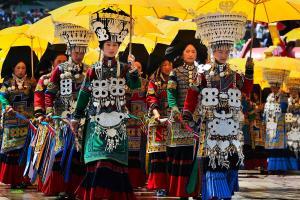
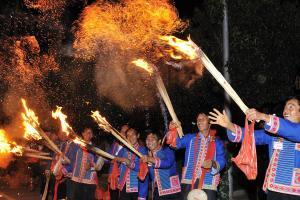
The Yi nationality The Torch Festival
The Yi people are superstitious. They worship nature and believe that everything in nature has an aura. Ethnic villages generally live together near the mountains and rivers, sheltered from the sun, lush trees, fertile land, open terrain, and conducive to farming, grazing, and military defense on the hillside. The Yi people usually celebrate the Yi New Year and the Torch Festival. The Yi New Year is a grand traditional festival for the Yi people in Sichuan, Yunnan, and Guizhou, but the time of the New Year varies from place to place. Torch Festival is a traditional festival of the Yi ethnic group holding a torch and wandering around the crop fields, meaning to burn the pests and pray for a good harvest.
· Bai
Bai Ethnic group is the 15th largest ethnic group in China, mainly distributed in Yunnan, Guizhou, Hunan, and other provinces, among which the largest population is Yunnan Province, living in Dali Bai Autonomous Prefecture in Yunnan Province. In addition, the Bai people also live in Sichuan and Chongqing provinces. The Bai people have their language. Believe in Buddhism.
March Street, also known as “Guanyin City.” is a grand festival and festival of the Bai people, held at the foot of the Diancang Mountain in the west of Dali City. Originally a religious event, it gradually became a grand material exchange.
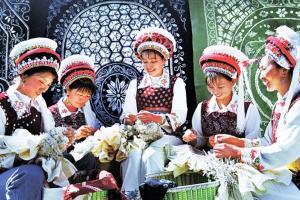

The Bai nationality The March Street
· Hani
The Hani, an international ethnic group living across the border, is one of the minority nationalities in China. The Hani mainly live between the Yuanjiang and Lancang rivers in Yunnan Province, China. The religious beliefs of the Hani people are multi-god worship and ancestor worship.
The Hani people are mainly engaged in agriculture and are good at growing tea. The history of tea cultivation by the Hani people is quite long in Xishuangbanna Gelang and Nannuo Mountain, which are famous for “Pu’er Tea,” which is a significant production area, and production of tea in the Hani area accounted for one-third of the output of the province of Yunnan.
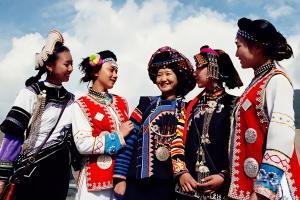
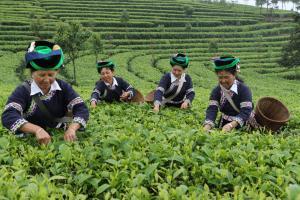
The Bai nationality Plant Pu 'er tea
·Dai
The Dai people, known as the Tai and the Shan, speak the Dai language. The Dai live in China, India, Vietnam, Cambodia, and Thailand. In 2000, there were 1,159,000 Dai in China. In 2000, there were 1,159,000 Dai people in China, mainly living in Xishuangbanna Dai Autonomous Prefecture in Yunnan Province. According to the China Statistical Yearbook-2021, the population of the Dai in China is 1,329,985.
The staple food of the Dai people is mainly rice. The Dehong area eats round-grained rice, and Xishuangbanna and other places love to eat glutinous rice, which is usually pounded and eaten now. The Dai also eat insects. The Dai region is humid and hot, with a diversity of insects. The Dai people have a traditional Dai opera. In the past, Xishuangbanna had a dance-based form of singing opera lyrics, which was the prototype of Dai opera. Its plot is relatively simple, mainly showing the knife-wielding hunters struggling with the disguised dragons, phoenixes, turtles, and cranes.
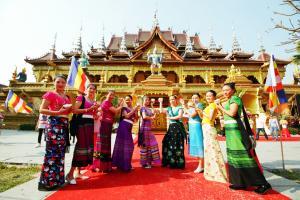
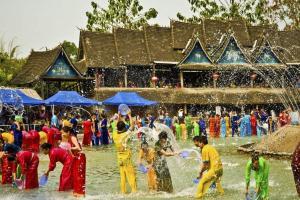
The Dai nationality Plant Pu 'er tea
· Zhuang
The Zhuang, one of the most populous ethnic minorities in China,speak the Zhunag language. According to the China Statistical Yearbook-2021, the population of the Zhuang within China is 1,956,8546. The Zhuang are found in 31 provinces, autonomous regions, and municipalities directly under the central government in China. Mainly reside in the south.
The Zhuang does not have a unified religious belief. The Zhuang are one of the earliest ethnic groups to cultivate and grow rice, with a deep developed rice culture, and rice has naturally become the staple food of the Zhuang people. Chewing betel nut is a traditional custom of the Zhuang, and Zhuang women in Longzhou and other places in present-day Guangxi still have this preference. In some areas, betel nut is a necessity for entertaining guests. They will celebrate the Double-Third Festival, Spring Festival, Longduan Festival, and other festivals, some of which are the same as the local Han people.
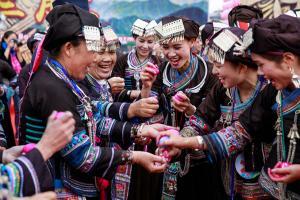
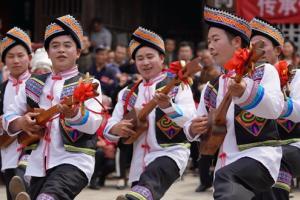
The Zhuang Nationality The Double-Third Festival
· Miao
The Miao, an ancient ethnic group, can be traced back to the era of the Yanhuang legend, 5,000 to 6,000 years ago. They are mainly in the provinces in China and regions of Qian, Xiang, E, Sichuan, Yunnan, Gui, and Qiong in China. According to the China Statistical Yearbook-2021, the population of Miao within China is 11067929.
The Hmong people have had their own religious beliefs for a long time. After a long period of historical development, the religious beliefs of the Miao people in different regions vary. The main objects of nature worship by the Miao include heaven, earth, sun, moon, boulders, big trees, bamboo, mountain rocks, and bridges. Embroidery is a long-established handcraft art of the Miao, the means of decoration for Miao clothing. The Miao is an ethnic group rich in ancient civilization and rituals, with unique and distinctive festivals at all times of the year. There are festivals of agricultural activities, quality exchange festivals, sacrificial festivals, and other festivals.
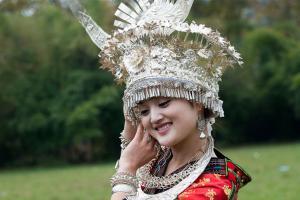
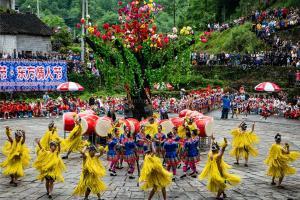
The Miao Nationality Miao nationality dance




































